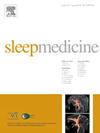Associations between sleep opportunity, sleep problems, and social jetlag and toddlers' adiposity: A cross-sectional study
IF 3.8
2区 医学
Q1 CLINICAL NEUROLOGY
引用次数: 0
Abstract
This study aims to analyze the associations between sleep characteristics, including sleep opportunity, problems and social jetlag, and toddlers' adiposity. It is part of a larger research project involving 344 children (mean ± SD age of 23.6 ± 6.3 months). Children's length/height, weight and waist circumference were measured at childcare centers. Body Mass Index (BMI), weight-for-length/height, and waist-to-length/height were calculated and classified according to percentiles, serving as surrogates of adiposity. Sleep problems were evaluated through questionnaire. Sleep opportunity was reported by parents and defined as the difference between bedtime and wake-up time. Social jetlag was calculated based on sleep midpoints. Parental questionnaires provided sociodemographic characteristics. Total energy intake was determined from a two-day dietary record, and motor development was assessed using the Bayley-III scales. Generalized linear models were used in the analysis. We found that nighttime sleep opportunity on weekdays was inversely associated with BMI percentile (B = −5.57, 95 % CI -9.79 to −1.35), even with covariates included. Additionally, later bedtime on weekend days were associated with lower weight-for-length/height and waist-to-length/height (B = −4.16, 95 % CI -8.01 to −0.30, and B = −10.62, 95 % CI -15.38 to −5.87, respectively), even when adjusted for potential confounders. Later bedtime on weekdays was associated with lower waist-to-length/height (B = −8.85, 95 % CI -14.95 to −2.74). Social jetlag was associated with lower waist-to-length/height (B = −7.19, 95 % CI -13.47 to −0.90). Future research is needed to clarify these associations and to encourage lifestyle-based interventions aimed at optimizing sleep patterns within this age group.
睡眠机会、睡眠问题和社会时差与幼儿肥胖之间的关系:横断面研究
本研究旨在分析睡眠特征(包括睡眠机会、问题和社会时差)与幼儿肥胖之间的关系。这是一个更大的研究项目的一部分,涉及344名儿童(平均±SD年龄23.6±6.3个月)。在托儿中心测量儿童的身高、体重和腰围。计算身体质量指数(BMI)、体重/身高、腰围/身高,并按百分位数进行分类,作为肥胖的替代指标。通过问卷调查对睡眠问题进行评估。睡眠机会由父母报告,并定义为就寝时间和起床时间之间的差异。社交时差是根据睡眠中点计算的。父母问卷提供了社会人口学特征。从两天的饮食记录中确定总能量摄入,并使用Bayley-III量表评估运动发育。分析中采用广义线性模型。我们发现,即使包括协变量,工作日夜间睡眠时间与BMI百分位数呈负相关(B = -5.57, 95% CI -9.79至-1.35)。此外,周末晚睡与较低的体重/身高和腰长/身高相关(B = -4.16, 95% CI -8.01至-0.30,B = -10.62, 95% CI -15.38至-5.87),即使校正了潜在的混杂因素。工作日较晚的就寝时间与较低的腰长/身高相关(B = -8.85, 95% CI -14.95至-2.74)。社交时差与较低的腰长/身高相关(B = -7.19, 95% CI -13.47至-0.90)。未来的研究需要澄清这些关联,并鼓励以生活方式为基础的干预措施,旨在优化这一年龄组的睡眠模式。
本文章由计算机程序翻译,如有差异,请以英文原文为准。
求助全文
约1分钟内获得全文
求助全文
来源期刊

Sleep medicine
医学-临床神经学
CiteScore
8.40
自引率
6.20%
发文量
1060
审稿时长
49 days
期刊介绍:
Sleep Medicine aims to be a journal no one involved in clinical sleep medicine can do without.
A journal primarily focussing on the human aspects of sleep, integrating the various disciplines that are involved in sleep medicine: neurology, clinical neurophysiology, internal medicine (particularly pulmonology and cardiology), psychology, psychiatry, sleep technology, pediatrics, neurosurgery, otorhinolaryngology, and dentistry.
The journal publishes the following types of articles: Reviews (also intended as a way to bridge the gap between basic sleep research and clinical relevance); Original Research Articles; Full-length articles; Brief communications; Controversies; Case reports; Letters to the Editor; Journal search and commentaries; Book reviews; Meeting announcements; Listing of relevant organisations plus web sites.
 求助内容:
求助内容: 应助结果提醒方式:
应助结果提醒方式:


